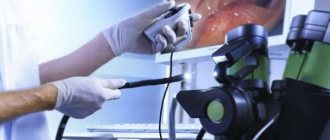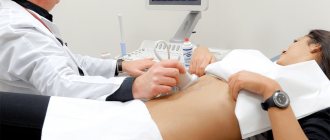What is a virtual colonoscopy
The technique is also called MSCT colonoscopy. It is used to examine the intestinal mucosa throughout the organ.
The method is based on multislice or multilayer computed tomography. The image is transmitted to the monitor, which allows the specialist to examine the condition of the organ and its individual segments.
A three-dimensional image is obtained using special X-rays. They are able to pass through tissues and display their condition.
Virtual colonoscopy of the intestine has several differences from other methods of diagnosing intestinal diseases. This method is absolutely safe for the human body. The resulting picture is quite clear.
The procedure is carried out only under the guidance of specialists in a hospital setting after training.
MSCT virtual colonoscopy – how it works
Multidetector X-ray machines are equipped with several radiation sensors located at a distance of several millimeters. Due to this design, in one rotation of the installation circuit, which is performed in 0.3-1 seconds, sections of a large part of the intestine can be made.
In fact, virtual colonoscopy of the intestine in St. Petersburg or Moscow takes a little longer due to the need to introduce a contrast agent to enhance the visibility of the intestinal wall.
Iodine-containing drugs are administered sequentially using automatic injectors installed directly into MSCT devices. Enhancement is carried out if a tumor is suspected, or if it is necessary to study the vascular network.
The price of virtual colonoscopy without contrast when compared with its endoscopic counterpart is approximately the same.
Indications for CT examination of the intestine (according to the standards of the World Health Organization):
- Dynamic assessment of the condition of the intestine after manipulation of tumors and polyps;
- Suspicion of foreign bodies inside the gastrointestinal tract;
- Sharp weight loss, anemic syndrome;
- Pain inside the abdomen;
- Discharge of mucus, blood, pus from the anus.
When preparing for a virtual colonoscopy, you can do without enemas by using an alternative regimen of taking laxatives the day before the scan and limiting food intake 7 hours before the test.
Otherwise, preparing for a virtual intestinal colonoscopy is simple - gas-forming products are excluded from the menu for 2-3 days.
Indications
An examination of the intestines using virtual colonoscopy is prescribed if the presence of cancerous and benign neoplasms affecting the mucous membranes of the organ is suspected.
Indications also include anemia, the causes of which could not be determined using other diagnostic methods, a positive test for tumor markers, and the presence of hidden blood in the stool.
Colonoscopy is also used in cases where it is not possible to conduct an endoscopic examination or there is a likelihood of developing a malignant tumor.
The procedure is also prescribed when symptoms such as regular intestinal and gastric bleeding, abdominal pain, inflammation, and intestinal dysfunction occur.
Virtual colonoscopy is also used when the patient’s general condition worsens due to anemia.
Contraindications
The procedure for diagnosing intestinal diseases also has contraindications. First of all, it is not used to study the organ during pregnancy and breastfeeding. Such contraindications are temporary.
Virtual colonoscopy is not performed for established acute abdominal diseases and organ damage.
The procedure cannot be prescribed to children under 14 years of age and people whose body weight is more than 120 kg.
On this topic
- Other diagnostic methods
What is the difference between histology and cytology
- Olga Vladimirovna Khazova
- December 4, 2020
It is also necessary to temporarily postpone the study in cases where the patient has a cold, for example, ARVI or influenza, general weakness is detected, or an elevated body temperature is observed.
Virtual colonoscopy is not used for diagnostic purposes for heart failure, pulmonary failure, or ischemic colitis.
Who should have a virtual colonoscopy?
Its implementation can be divided into diagnostic and screening studies. The patient groups in these cases are also different. So, for diagnostic purposes it is carried out:
- with regular gastrointestinal bleeding;
- with iron deficiency anemia, the causes of which are not clear;
- after a traditional colonoscopy, if in that case it was not possible to reach certain areas of the intestine;
- in the presence of polyps - to control their dynamics and growth;
- for any pain of unknown origin in the intestinal area and lower abdomen.
A screening study usually involves a medical examination, and there are patients at risk. In what cases can a virtual colonoscopy be performed:
- if the patient has a family history of cancer localized in the intestinal area;
- when the patient reaches 50 years of age;
- with multiple intestinal polyps;
- if traces of blood are detected in stool tests;
- with positive results for tumor markers.
Preparing for a virtual colonoscopy
How to prepare for the procedure? The preparatory steps here combine recommendations from traditional colonoscopy and magnetic resonance imaging. So, from the first method, here are tips on bowel preparation:
- a light diet in the previous couple of days before the diagnosis;
- on the day of the procedure, only drinking water is allowed;
- emptying the intestines of feces using an enema or taking laxatives.
As an additional method of preparation, the doctor suggests that the patient drink a liquid containing a small amount of iodine or barium. When the liquid penetrates the intestines, it will help the specialist distinguish polyps and neoplasms from stool residues in the intestines.
As for the preparation elements that are similar when performing an MRI of the intestine, they are as follows:
- Before the procedure, you must remove all metal objects (jewelry, watches) that will interfere with the correct assessment of the results;
- the patient should warn the doctor about the presence of an allergic reaction to iodine.
How is a virtual colonoscopy performed?
Immediately before the procedure, about 2 liters of gas are pumped into the patient’s intestines. This is done under low pressure, no more than 30 mm Hg. This is perhaps the only inconvenience in the entire study.
The patient is placed on a table, which is then pushed into a large circle - a tomograph. This circle will rotate during the procedure, and the table may move slightly horizontally. This is how the device takes pictures in different projections. The patient must remain calm during the procedure and try not to move so as not to distort the images.
Preparation
Before the procedure, the patient should follow all preparation rules. It should start 4 days before the study. First of all, you need to carefully monitor your personal hygiene. On the eve of a colonoscopy, it is important to cleanse the intestines. For this, laxatives or an enema are used.
During the preparation period, it is important to maintain proper nutrition. The diet should include semi-liquid or porridge-like soups.
All products that provoke gas formation must be excluded. These include black bread, leaf salads, cabbage, legumes, carbonated drinks, fermented milk products, including milk.
Patients are advised to avoid spicy seasonings, smoked, salty and fatty foods. This is due to the fact that they irritate the intestines. Millet and wheat porridge also have a negative effect on the organ mucosa.
Experts recommend consuming soups, broths based on lean meat or fish, and white crackers during the preparation period.
Drinking, except carbonated drinks, is not limited. Fruit drinks, juices, compotes and still water can be consumed without restrictions. An hour before the test you need to drink a liter of liquid. It is prohibited to use activated carbon and iron supplements.
It is important for the patient to know that virtual colonoscopy is performed on an empty stomach. You should not eat food the day before the procedure.
On this topic
- Other diagnostic methods
BRAF mutation
- Olga Vladimirovna Khazova
- October 17, 2020
The night before and 3 hours before the examination, you must do a cleansing enema. To do this, use a ready-made microenema, which can be purchased at the pharmacy.
In some cases, it is allowed to take laxatives. The most commonly used is Fortrans.
Before use, you need to study the instructions for use. The solution has a sweet taste. It can be consumed chilled and added with citrus juice.
Before the study, you must inform your doctor about the presence of chronic diseases. 6-8 days before the procedure, you should stop taking any medications that contain aspirin.
A contrast agent is used as prescribed by the attending physician.
Preparation for a colonoscopy requires careful adherence, since the reliability of the data obtained depends on it.
What to take with you
Before carrying out the procedure, it is important not only to prepare properly, but also to collect the necessary package of documents.
On this topic
- Other diagnostic methods
Everything you need to know about oncocytology
- Olga Vladimirovna Khazova
- May 27, 2020
First of all, you will need a referral from your doctor. The specialist will determine the presence of contraindications and indications for the procedure.
An outpatient card, results of other studies for other diseases and other documents related to the disease will be required.
How is the procedure performed?
The study is carried out after the specialist instructs the patient about possible risks and the course of the procedure.
Virtual colonoscopy is usually performed in private clinics. There, the patient is often given special disposable clothing. This is a sheet, shoe covers, a robe. The patient needs to change clothes and lie on the couch on his left side.
To obtain reliable information, it is necessary that there is air in the intestines. For the purpose of pumping it, a disposable special tube is used, which is inserted into the anus. It is first lubricated with Vaseline. Its second end is connected to the pump.
On this topic
- Other diagnostic methods
What is a cytological examination
- Olga Vladimirovna Khazova
- May 27, 2020
The patient should roll over onto his back. An X-ray machine is sent to the intestinal area and scans. A repeated procedure is performed after the patient turns over onto his stomach.
The device is controlled using a special remote control, which is located in the next office. The patient must strictly follow all the specialist’s instructions.
The duration of the procedure takes from 15 to 30 minutes.
How is a virtual colonoscopy performed?
For the examination, a special CT or MSCT device is used. The cost of research with the second option is higher, but the efficiency is an order of magnitude higher. Human tissues transmit x-rays differently, and any x-ray examination is based on this principle.
During a virtual colonoscopy, the patient is placed in a special device in a lying position. The tomograph makes circular movements around a person, taking a series of pictures from different points. The information is sent to the computer and processed. Reviews from doctors indicate that this procedure is sufficiently effective for diagnosing most diseases.
The entire study takes no more than 40 minutes. The doctor has the ability to communicate two-way with the patient in the tomograph. If necessary, he may ask you to change your body position, hold your breath, or calm the person down if you are very nervous.
What diseases can be diagnosed
The study is carried out using x-ray scanning. The resulting image is displayed on the monitor. Thanks to the ability to obtain a three-dimensional image, the specialist is able to determine the structure of the intestinal mucosa and the condition of the blood vessels.
In this way, the doctor can analyze the data obtained in real time. Using virtual colonoscopy, it is possible to determine the source of bleeding, the presence of ulcers and other mucosal defects.
One of the advantages of the technique is the ability to identify tumors with a diameter of more than 0.1 centimeters.
Thanks to this diagnostic method, it is possible to timely determine the presence of a number of diseases associated with the spread of the inflammatory process on the intestinal mucosa.
Decoding the results
After the procedure, the patient can receive the scan results in his hands after 30-50 minutes. The specialist will need time to process the received data and combine the images into one picture.
The results may be positive or negative. In the first case, the image reveals darkened areas, structural changes and tumors of various sizes.
A negative result is determined in the absence of certain abnormalities. If the patient still has unpleasant symptoms, the cause of their occurrence should be sought using other methods.
What influences the reliability of the results
MSCT is highly informative compared to other techniques. But the results may not always be reliable. Factors that may affect the reliability of the data include improper preparation, accumulation of blood in some parts of the intestine, and poor cleaning.
Also, the result may not be accurate enough due to intestinal rigidity, which is observed after illnesses.
To obtain the most accurate MSCT data, it is important to strictly follow the specialist’s recommendations during preparation and during the procedure.
Carrying out the procedure
Let's briefly look at the process of carrying out this procedure. As for its duration, this is ambiguous, because in most situations it does not exceed 20 minutes, but sometimes more shots are required, and contrast can significantly increase the duration if it is used. Here is the basic information that is important to know:
- Before the procedure begins, air will be pumped into your intestines to straighten the walls. This must be done after the patient lies down on the couch.
- Now the patient will be placed in a special scanner, where pictures will be taken in various projections, and the equipment itself rotates around the person.
- Be sure to listen to the doctor as carefully as possible during the process; he will notify you via speakerphone about the need for certain actions, for example, changing position or holding your breath.
- At the end of the procedure, excess air will be removed from your intestines using a special tube.
- Results will be received within 1 hour.
Are there any complications?
Virtual colonoscopy is a safe method for diagnosing intestinal diseases. But after the procedure, certain complications may occur.
On this topic
- Other diagnostic methods
Features of sputum cytology
- Olga Vladimirovna Khazova
- May 27, 2020
Most often, an allergic reaction to the contrast agent is observed. It manifests itself in the form of itching, rash on the skin, and redness.
X-ray radiation from the device is harmful to the human body, but a single examination leaves virtually no traces. The danger comes from constant exposure to radiation.
In exceptional cases, perforation of the intestinal walls occurs, resulting from the injection of air. This complication occurs in rare cases. The cause is improper preparation or research.
Advantages and disadvantages
Virtual colonoscopy is a modern method for diagnosing intestinal pathology. This method has many advantages over other methods. But there are also disadvantages.
Advantages
The procedure for inserting a tube through which air is pumped is unpleasant, even despite the use of sedatives.
Virtual colonoscopy is very popular due to a number of advantages.
First of all, the procedure extremely rarely causes complications, such as perforation of the walls of the organ being examined.
The advantages of the method also include:
- Possibility of obtaining more than 1000 images in a few minutes. This allows you to more accurately determine the location and extent of the pathological process. Thanks to the images, the diagnosis can be established within an hour.
- No anesthesia. The procedure is painless and the presence of an anesthesiologist is not required.
- Minimal number of contraindications. Virtual colonoscopy can also be used to diagnose intestinal diseases in cases where the patient has contraindications to other techniques. The procedure can also be used in cases where there is reduced immunity due to other diseases.
- Possibility of prescription in the presence of bleeding, peptic ulcer, polyps, pathologies of the respiratory system.
- Appointment at any age. Contraindication is only for those under 14 years of age.
- Definition. In the images, a specialist can examine all areas that are difficult to reach with other diagnostic methods.
- accuracy . If the procedure is performed correctly, it is possible to obtain the most accurate picture.
The specialist receives all information about the state of the intestines within 5 minutes after the start of the procedure.
Virtual colonoscopy has many positive patient reviews. The procedure is much more comfortable than other methods. After diagnosis, there are practically no side effects, and the state of health does not worsen.
But the most important advantage of the procedure is its non-invasiveness. When performing MSCT, there is no need to insert a special probe into the anal passage.
Flaws
In the case when a retracted or flat neoplasm is formed on the intestinal mucosa, it is almost impossible to distinguish them from the surface of the organ. Thus, there is some difficulty in making a correct diagnosis.
On this topic
- Other diagnostic methods
When is urine cytology necessary?
- Olga Vladimirovna Khazova
- May 27, 2020
Also, using the procedure, it is impossible to obtain the amount of information that allows you to determine all catarrhal changes. It is impossible for a specialist to fully assess the extent of the pathological process based on images.
In addition, there is a risk of obtaining unreliable results due to improper preparation. To obtain accurate information, experts recommend following the recommendations.
Advantages and disadvantages of the procedure
Let's summarize the previously mentioned information and collect the advantages and disadvantages of the procedure in question. Here are its main advantages:
- Non-invasive, meaning there is no need to insert special instruments into the intestines through the anus.
- Significantly minimizing the risk of penetrating damage to the colon itself in the process.
- Easy tolerability by all patients, absence of any requirements for the use of sedative anesthesia.
- The ability to study other organs located in the pelvis, as well as in the abdominal cavity.
But the procedure also has disadvantages, here are the main ones:
- If there is bloating of the intestines before the procedure, there is a risk that it will be damaged.
- The procedure still poses some danger due to the radiation carried in X-rays.
- This procedure is technically difficult for those people who suffer from obesity, especially if it is severe.
It is worth understanding that this method cannot replace conventional colonoscopy; it is intended solely for diagnostic purposes.
Which is better: CT scan of the intestine or colonoscopy?
Computed tomography of the intestine is based on the physical effects of radiation from an X-ray machine. As a result, the body receives insignificant radiation exposure.
Virtual colonoscopy also involves the use of an X-ray machine. But at the same time, the radiation that is harmful to the body is much less.
One of the advantages of CT is the absence of complications. If MSCT is performed, there is a possibility of intestinal perforation.
Colonography allows you to determine the presence of neoplasms, even small ones. Computed tomography cannot detect tumors, polyps and other growths in the early stages of their development. As a result, the specialist will not be able to make a diagnosis in a timely manner.
CT does not allow analysis of the structure of the mucosa, even despite the possibility of layer-by-layer images. MSCT in the presence of minor changes in the intestinal surface will be a more informative method.
Thus, CT and colonoscopy have some differences. But despite them, these methods can be interchangeable or used together in complex diagnostics.
The type of research to be performed is determined by the attending physician based on indications, contraindications and existing symptoms.
What is this?
Virtual colonoscopy is a type of computed tomography that allows you to create a three-dimensional image of different parts of the intestine. The resulting images are very similar to the results of an ordinary examination using an endoscope.
With the help of computed tomography, you can clearly see every centimeter of the surface of the intestine along its entire length.
Experts note that such an examination is multispiral, that is, multilayered. For this reason, the study received another abbreviation name, namely, MSCT colonoscopy or CT colonography. For this reason, the question of which is better: colonoscopy or CT scan does not make sense. This procedure is carried out using special equipment, and in the process, which is typical of any computed tomography, X-rays are used. The equipment receives them after passing through the tissues of the human body, and then analyzes and creates images. Here are the main features of the procedure:
- The method differs from magnetic resonance imaging in the quality of the image and the technology itself, because MRI uses the properties of the electromagnetic field, and computed tomography uses X-rays.
- As for the differences from endoscopy, the procedure in question does not involve any pain, and the resulting image is much more accurate (especially if the method is used with bolus contrast enhancement). Unfortunately, the method is slightly inferior to endoscopy in that it does not provide for the possibility of taking a biopsy sample, so it will not be possible to conduct its research. Thus, it is impossible to verify the presence or absence of oncology.
Experts note that virtual intestinal colonoscopy with contrast is a method that can perfectly show the condition of the intestines, including tumors, as well as erosions and ulcers. Fortunately, the possibilities are not limited to this, because the method allows you to identify many other changes, but still something does not fall under review, for example, the color of the mucous membrane or the smallest formations.
For this reason, we can conclude that colonoscopy using a computed tomograph should be performed when we are talking about patients with a fairly low risk of cancer. In other situations, many experts recommend replacing colonoscopy with something else, but all this is purely individual and should be determined by the attending physician in specific situations.










